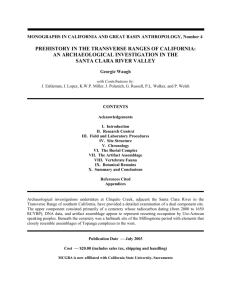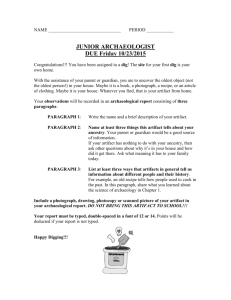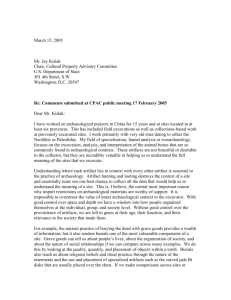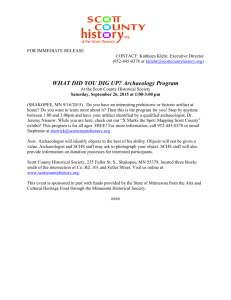Ashley Greene_ARCH 800_What is an Artifact
advertisement
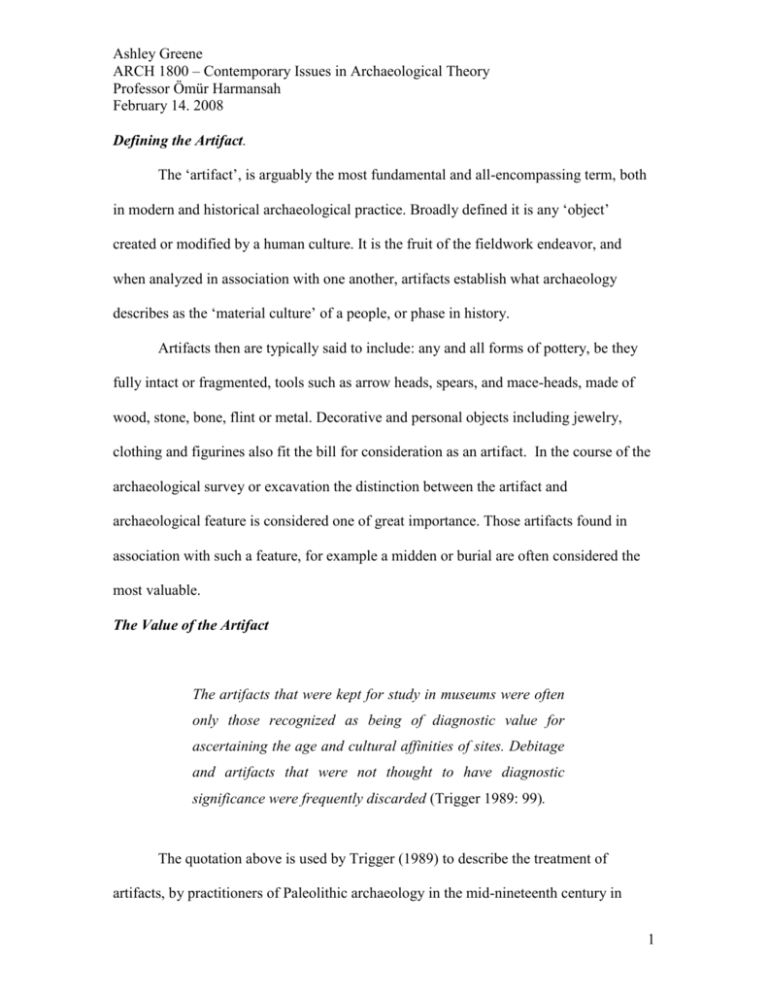
Ashley Greene ARCH 1800 – Contemporary Issues in Archaeological Theory Professor Ömür Harmansah February 14. 2008 Defining the Artifact. The ‘artifact’, is arguably the most fundamental and all-encompassing term, both in modern and historical archaeological practice. Broadly defined it is any ‘object’ created or modified by a human culture. It is the fruit of the fieldwork endeavor, and when analyzed in association with one another, artifacts establish what archaeology describes as the ‘material culture’ of a people, or phase in history. Artifacts then are typically said to include: any and all forms of pottery, be they fully intact or fragmented, tools such as arrow heads, spears, and mace-heads, made of wood, stone, bone, flint or metal. Decorative and personal objects including jewelry, clothing and figurines also fit the bill for consideration as an artifact. In the course of the archaeological survey or excavation the distinction between the artifact and archaeological feature is considered one of great importance. Those artifacts found in association with such a feature, for example a midden or burial are often considered the most valuable. The Value of the Artifact The artifacts that were kept for study in museums were often only those recognized as being of diagnostic value for ascertaining the age and cultural affinities of sites. Debitage and artifacts that were not thought to have diagnostic significance were frequently discarded (Trigger 1989: 99). The quotation above is used by Trigger (1989) to describe the treatment of artifacts, by practitioners of Paleolithic archaeology in the mid-nineteenth century in 1 Ashley Greene ARCH 1800 – Contemporary Issues in Archaeological Theory Professor Ömür Harmansah February 14. 2008 England and France. Perceptions of the relative value of artifacts are no less disputed in modern archaeological theory and practice. The so-called ‘debitage’ of an excavation is almost purely the left to the determination of the on-site supervising archaeologist. Where this individual has little or no research driven stake in the site (as would perhaps be the case with contract archaeologists) final word belongs to a laboratory archaeologist; who as Trigger suggest may have bias towards the ‘diagnostic value’ of the artifact. Alternatively a museum curator would be left to determine the significance of the artifact. In this instance standards of evaluating the artifact may be tied to its perceived artistic value and/or its ability to fit within the frame of a pre-existing, and pre-defined grouping of culturally related or typologically similar objects. Artifacts in the hands of the Archaeologist The artifact is a tool of great power in the hands of the archaeologist. Culture and histories are constructed and deconstructed by the archaeologist’s interpretation of artifacts. Even the most unique artifacts, or those found in complex assemblages cannot tell their own stories, they rely on the archaeologist’s analysis. How does the archaeologist wield this potent tool? What informs him as he draws a picture of a people or a period of time from a set of objects? The basic premise upon which the archaeologist bases his treatment of an artifact, is that which states that an objects manifestly translates to a person(s). This is not an unreasonable position; for every spear, for example, we may extrapolate a soldier/hunter to wield it. We may take this further imagine the craftsman who made it. A group of spears in close association with workmen’s tools leads us to interpret a site as the locus 2 Ashley Greene ARCH 1800 – Contemporary Issues in Archaeological Theory Professor Ömür Harmansah February 14. 2008 for the manufacture of weaponry. The more imaginative among us may speak from these associated groups of objects of a militaristic society. Common Find Artifact Assemblage Type-site Archaeological Culture Special Find The acceptance of this theoretical jump from artifact to archaeological culture (as illustrated in the model above) is manifest in the modern jargon of archaeology. “Formal artifact assemblages and their contexts can yield a systematic and understandable picture of total extinct cultures”. (Trigger 1989: 298). While the artifact assemblage is invaluable in understanding archaeological culture, the contextual comfort it provides alienates the unique find, devoid of context. The effect is the sacrificing of the systematic picture Trigger refers to above. From the concept of the assemblage, archaeologists construct the notion of the ‘type-site’, those sites considered archetype of a particular archaeological culture. If we distinguish a type-site by the particular assemblages it contains then another type of artifact inevitably emerges, the ‘special find’. No type of artifact is more vulnerable to the whims and biases and preconceived ideas of the archaeologist. The ‘special find/artifact only exists insofar as notions of a type-site have dictated what is a common find/artifact in a given assemblage. Once classified as a special find, it is still the prerogative of the 3 Ashley Greene ARCH 1800 – Contemporary Issues in Archaeological Theory Professor Ömür Harmansah February 14. 2008 archaeologist to determine if and to what extent these objects are incorporated into the interpretive framework of the site or phase. Conclusion While the relationship is never as straightforward as illustrated in the model, it is this theoretical jump from object to culture in archaeology that seems to obstruct the process towards a universally accepted definition of an artifact. The important question to ask one’s self is should such a concrete definition even be a goal of archaeology. Definitions marked by flexible parameters have been the lifeblood of the discipline since its inception and the method by which evolving theories have been allowed to emerge, and of course to attempt to shatter the previous theory. The current broad definition of the artifact still leaves room for it to be appreciated for probative scientific value, and for those who are more concerned with creating a picture of the man behind the spear. 4 Ashley Greene ARCH 1800 – Contemporary Issues in Archaeological Theory Professor Ömür Harmansah February 14. 2008 References Trigger, Bruce G (1989), A history of archaeological thought , Cambridge [England] ; New York : Cambridge University Press. 5

